This article has been
cited by other articles in ScienceCentral.
Abstract
We present a case of pediatric deceased donor liver transplantation using a reduced whole liver graft in a 25-month-old boy weighing 12.7 kg. After he had undergone Kasai portoenterostomy for biliary atresia, his general condition deteriorated progressively. He was enrolled on the waiting list for liver transplantation with Pediatric End-stage Liver Disease score of 15. The donor was a 51-monthold boy with body weight of 20 kg. The donor-to-recipient body weight ratio was 158%. The liver graft appeared to be larger than the recipient’s abdominal cavity. Thus, we planned to do in situ size reduction. Recipient surgery was performed following standard procedures. We performed graft outflow vein reconstruction using a modified piggyback technique like the double inferior vena cava method. Since the portal vein was hypoplastic, a side-to-side anastomosis technique was used. We also performed intraoperative portogram to embolize venous collaterals. After completing the graft implantation, we found that the liver graft was too large to be accommodated within the abdomen. After in situ resection of the left lateral section parenchyma, we successfully performed primary closure of the abdominal wound. This patient experienced episodes of acute rejection. He has been doing well for four years after the transplantation.
Go to :

Keywords: Large-for-size graft, Pediatric transplantation, Graft-recipient weight ratio, Reduced graft, Left lateral section
INTRODUCTION
Liver transplantation (LT) is a life-saving procedure for children with end-stage liver disease. The success of LT is attributed to the development of effective therapies for immunosuppression and evolution of surgical techniques that have allowed many more children to receive LT [
1-
3]. Because most pediatric recipients are under three years of age, there is a significant shortage of size-appropriate whole organs for these patients [
3]. Therefore, innovative surgical techniques have been developed to expand the procedure to a wider number of patients, including split deceased donor liver grafts, partial living donor liver graft, reduced and hyper-reduced liver grafts, and whole liver grafts.
Living donor liver transplantation (LDLT) has been frequently performed because of serious deceased donor shortage in Korea. Types of pediatric LT performed are in the order of LDLT, split LT, whole liver deceased donor LT, and reduced deceased donor LT. In real-world practice in Korea, if a whole liver from an adult deceased donor is too large for an adult patient, split LT for two adult patients is preferred instead of performing reduced LT [
4,
5]. In contrast, if a whole liver from a pediatric deceased donor is too large for a pediatric patient, there is no practical choice other than to perform reduced LT. Considering that the incidence of pediatric deceased donors is very low, the actual incidence of reduced LT for pediatric patients is much more lower in Korea. We herein present a case of reduced LT done in a 25-month-old recipient using a liver graft from a 51-month-old deceased donor.
Go to :

CASE
The recipient was a 25-month-old boy who had undergone Kasai portoenterostomy at the age of 2 months for biliary atresia. His height and body weight were 89 cm and 12.7 kg, respectively. His general condition and liver function deteriorated progressively. Thus, LT was planned (
Fig. 1). He was enrolled on the waiting list of LT of the Korean Network for Organ Sharing with a Pediatric End-stage Liver Disease score of 15 (total bilirubin level of 6.4 mg/dL, albumin level of 2.5 g/dL, prothrombin international normalized ratio of 1.37, and growth failure).
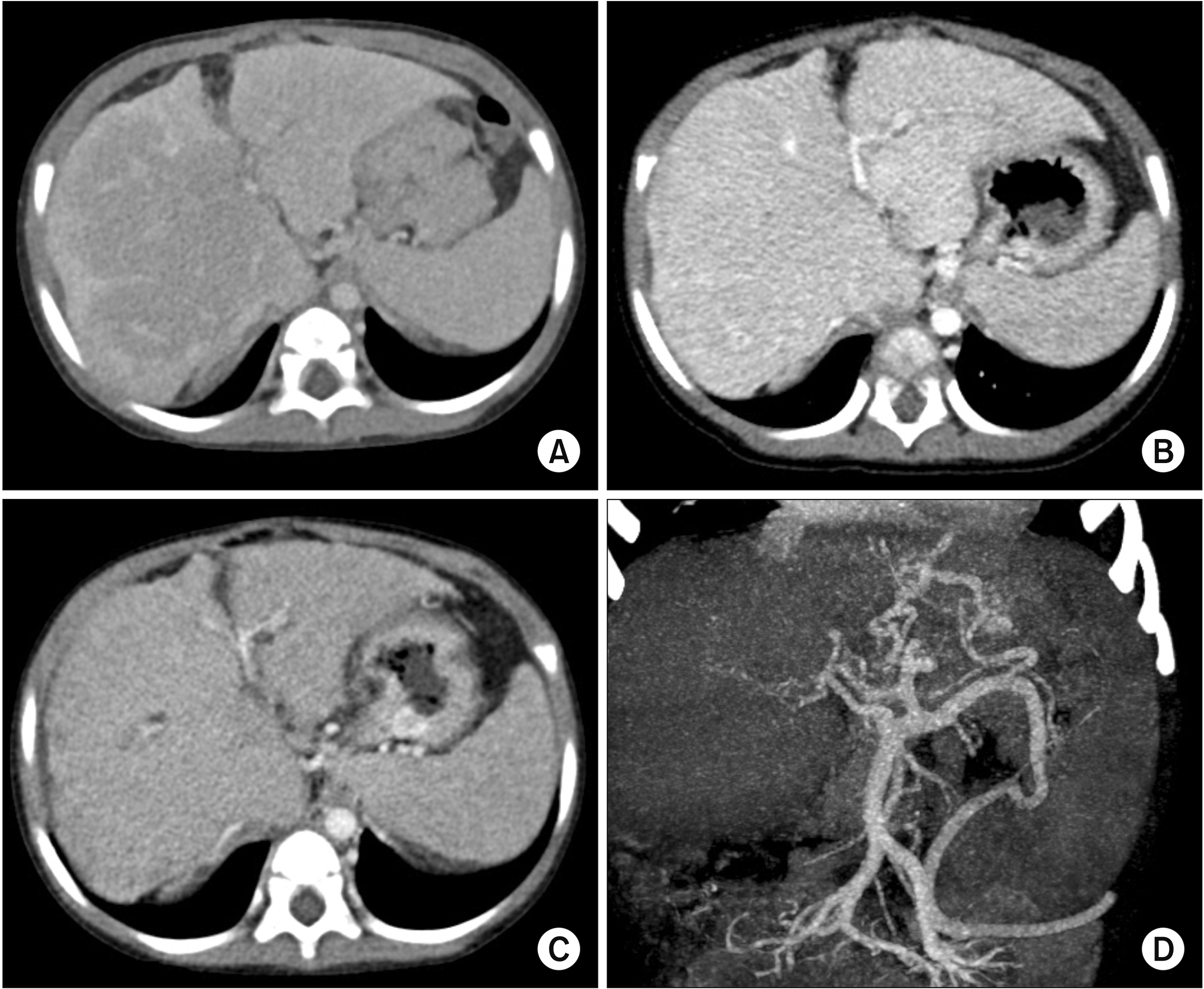 | Fig. 1Pretransplant computed tomography (CT) taken at 1 year (A), 6 months (B), and 1 month (C) before transplantation showing progression of liver cirrhosis. Hypoplastic portal vein with development of collateral veins were visible at the CT scan taken at 1 month before transplantation (D). 
|
After some waiting, a 51-month-old boy donor with height of 105 cm and body weight of 20 kg was allocated probably because their body weight ratio was between 50% and 200% (20 kg in donor compared to 12.7 kg in recipient, a ratio of 158%). The whole liver weighed 915 g on the back table, which had a graft-to-recipient weight ratio (GRWR) of 7.2%. The liver appeared to be larger than the recipient’s abdominal cavity. Thus, we planned to perform in situ size reduction if necessary.
We performed the recipient surgery according to standard procedures of pediatric whole LT. After recipient hepatectomy, we temporarily placed the whole liver graft in the abdomen for size matching. We then began the actual graft implantation. We performed graft outflow vein reconstruction using a modified piggyback technique by making a large triangular orifice as in a double inferior vena cava method. Since the portal vein was hypoplastic, we used a side-to-side anastomosis technique to prevent anastomotic stenosis. The hepatic artery was reconstructed under surgical microscopy. We performed hepaticojejunostomy using the preformed Roux-en-Y jejunal limb.
After completing graft implantation procedures, we found that the liver graft was too large to be accommodated within the abdomen. Since the left liver was large, we decided to perform
in situ resection of the left lateral section parenchyma (
Fig. 2). By using a Cavitron ultrasonic aspirator without hepatic inflow occlusion, we resected the left lateral section meticulously. The resected parenchyma of the left lateral section weighed 122 g. Thus, the weight of the implanted right trisection graft was arithmetically 793 g, having a GRWR of 6.2%. The recipient’s native liver weighed 506 g (
Fig. 3), which had a GRWR of 4.0%. Thus, we decided to perform primary closure of the abdominal wound.
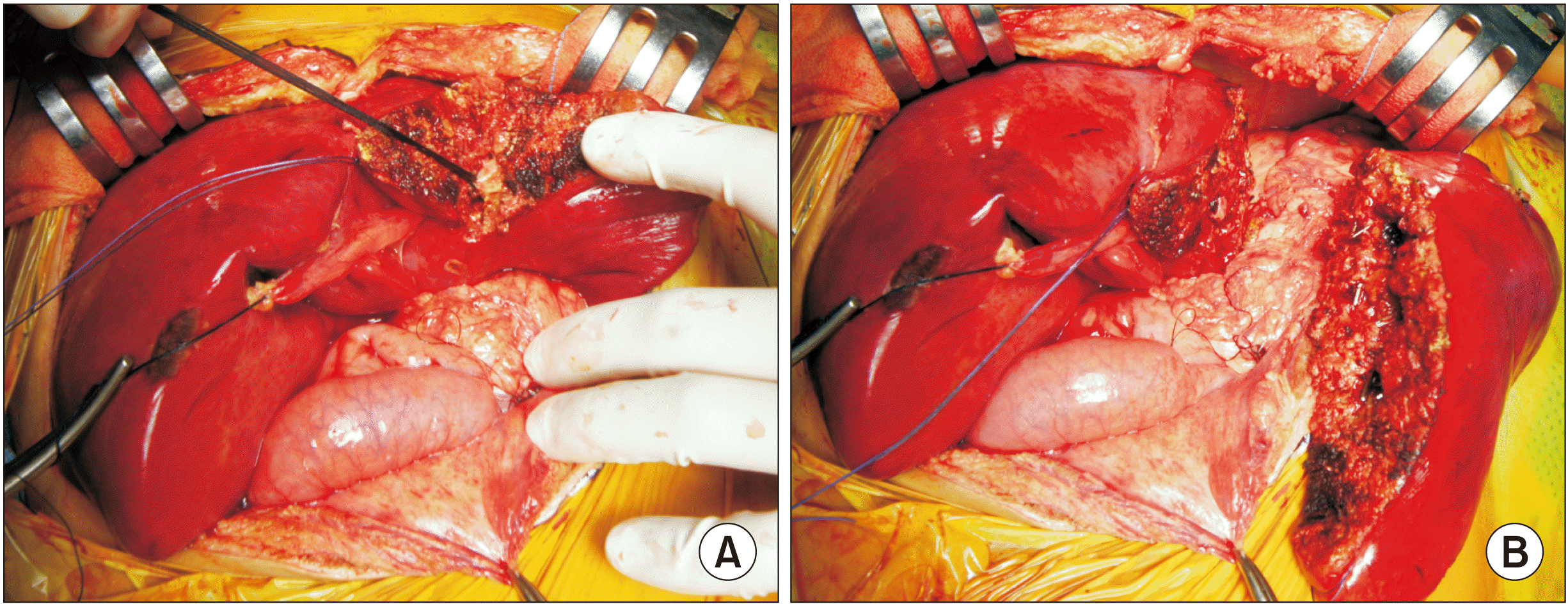 | Fig. 2Intraoperative photographs showing in situ size reduction of the whole liver graft. The left lateral section parenchyma was transected (A) and removed (B) to perform primary closure of the abdominal wound. 
|
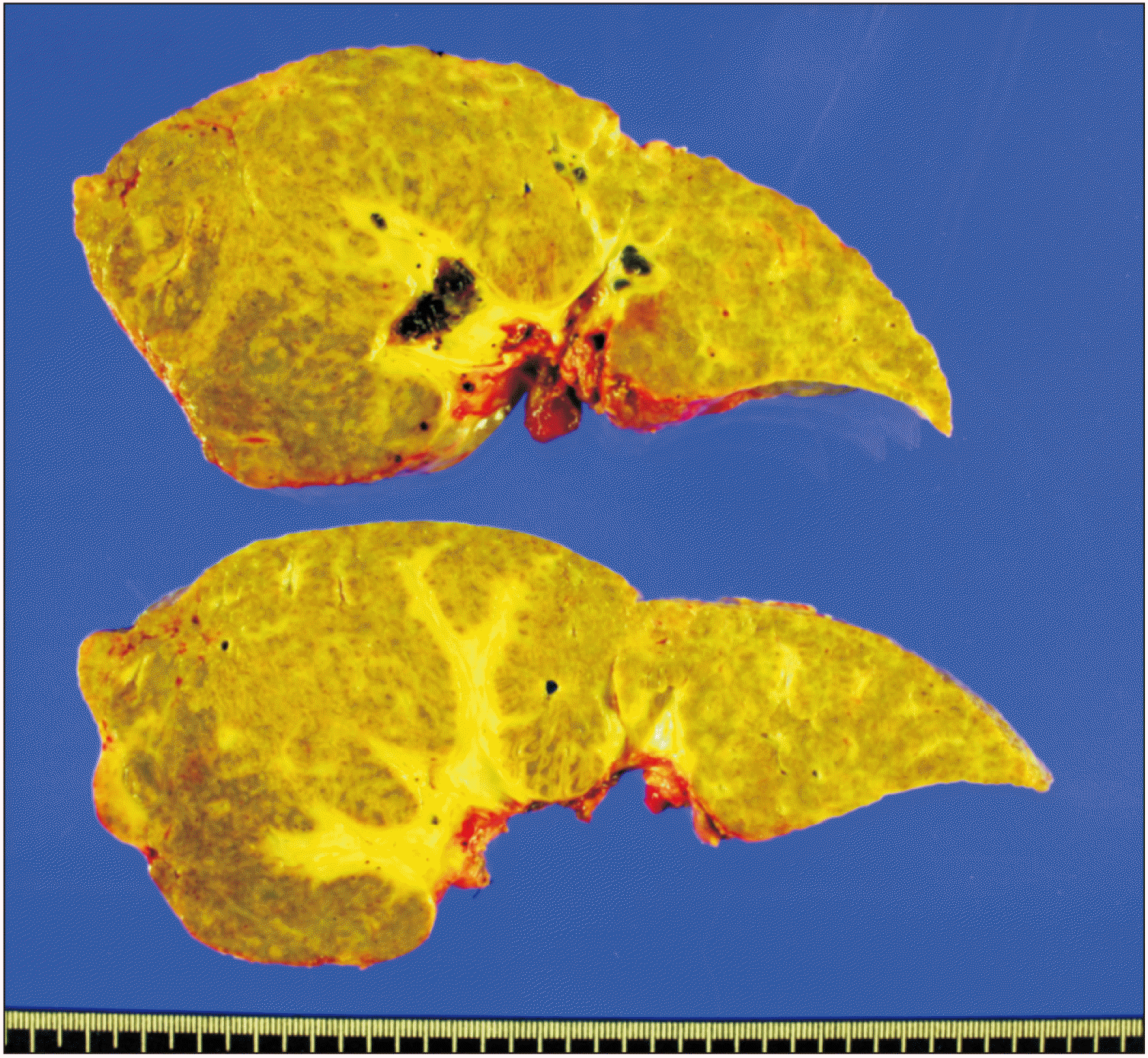 | Fig. 3Gross photograph of the explanted native liver, showing hepatomegaly combined with advanced liver cirrhosis. 
|
There were some venous collaterals because of portal hypertension. Thus, we performed direct portography through a small branch of the superior mesenteric vein, in which the portal blood flow was well preserved. We embolized some collateral veins from the splenic hilum with coils to prevent the risk of portal steal phenomenon (
Fig. 4).
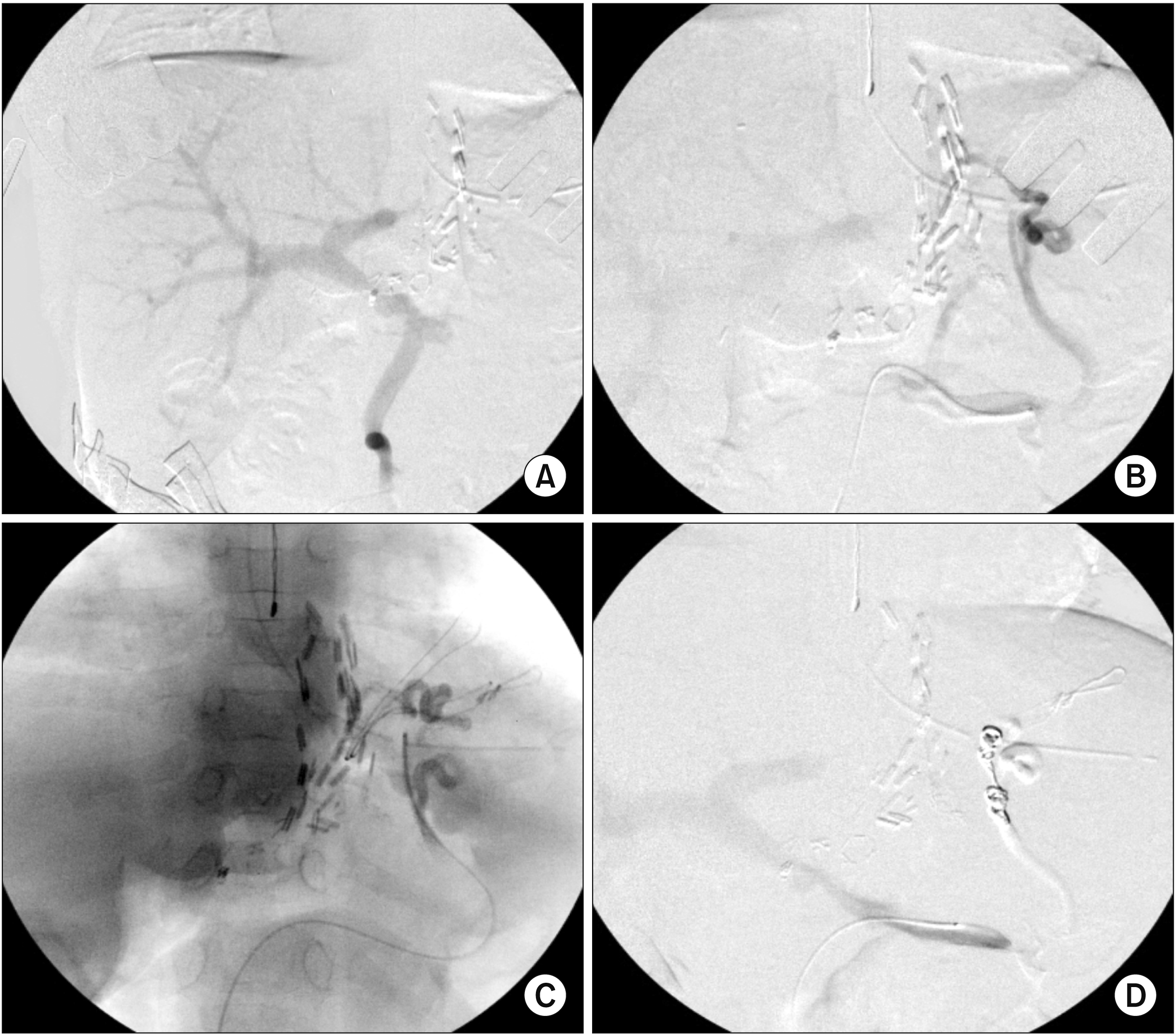 | Fig. 4Findings of intraoperative direct portography. The reconstructed portal vein showed good blood flow (A). Some collateral veins form the splenic hilum were identified (B, C) and completely embolized with coils (D). 
|
Posttransplant peak values of the liver function test during the first week after transplantation were: serum aspartate transaminase of 330 IU/L, alanine transaminase of 391 IU/L, and total bilirubin of 3.4 mg/dL. Follow-up computed tomography (CT) scan taken at 4 days posttransplant showed parenchymal ischemia at the right posterior section (
Fig. 5), which might have been associated with extrinsic liver compression by the tight abdominal wall.
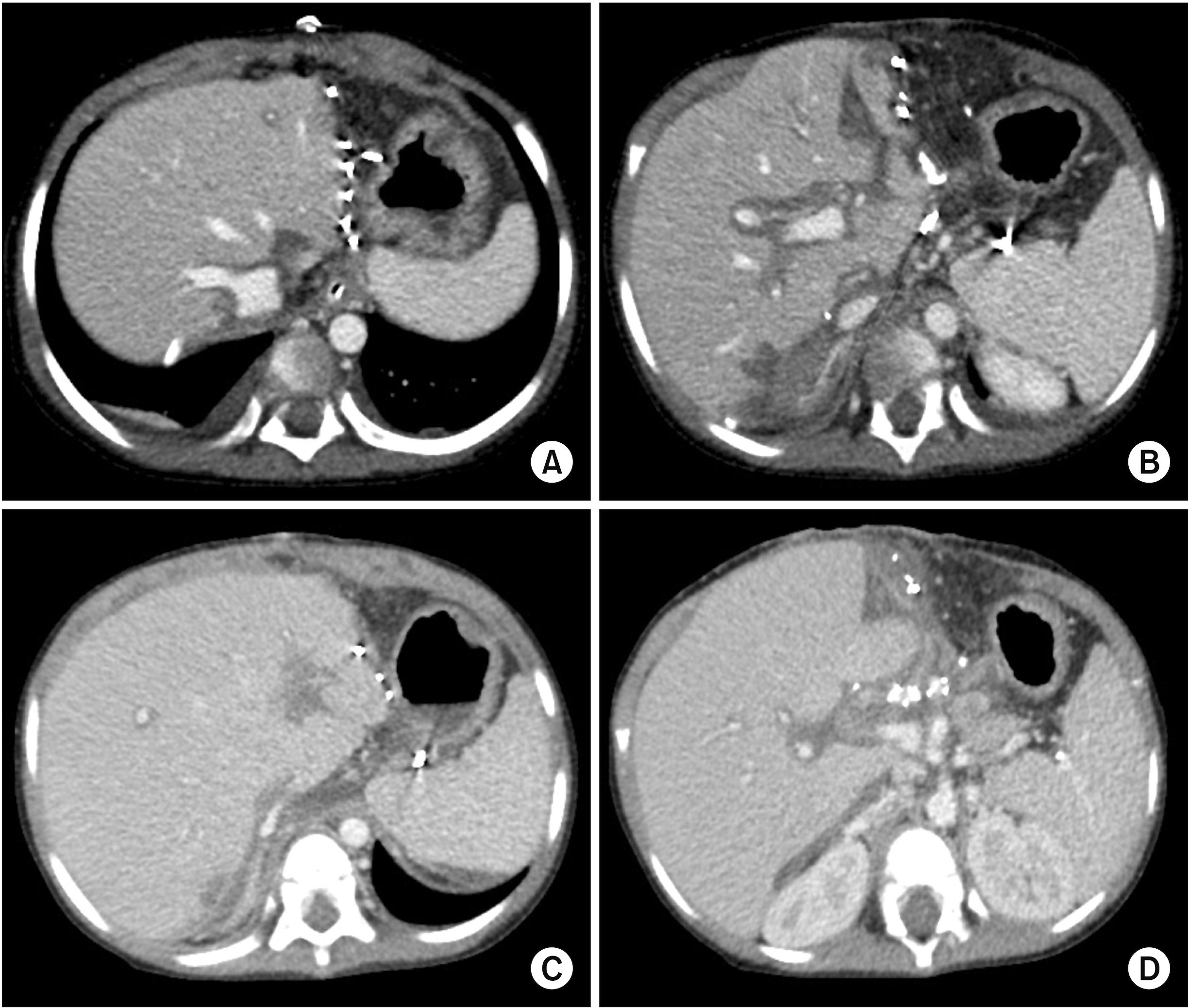 | Fig. 5Posttransplant computed tomography (CT) scan follow-up. The CT scan taken 4 days after transplantation showed parenchymal ischemia at the right posterior section (A, B). The CT scan taken 14 days after transplantation showed resolution of the parenchymal ischemia (C, D). However, swelling of the liver graft and ascites developed because of acute cellular rejection. 
|
Two weeks after the transplantation, a follow-up CT scan showed resolution of the ischemic portion at the right posterior section (
Fig. 5). However, ascites developed. Since his liver enzymes were elevated again, we performed a percutaneous liver core biopsy at 18 days posttransplant, in which the pathology finding was consistent with acute cellular rejection, with a rejection activity index of 6. The liver function gradually recovered after immunosuppression was augmented with steroids. Thereafter, this patient experienced two episodes of biopsy-proven mild acute cellular rejection, one at 4 months and one at 16 months posttransplant. The patient has been doing well for four years after the transplantation.
Go to :

DISCUSSION
Although experience with LT for infant and toddler patients has been accumulating worldwide, large-for-size graft-related problems still remain as big huddles for successful LT. The main problems of large-for-size grafts include the risk of abdominal compartment syndrome because of the recipient’s small abdominal cavity, discrepancies in vessel size, insufficient portal circulation, and insufficient tissue oxygenation [
6-
10]. Size reduction of the graft is a definite treatment to prevent these critical problems.
In infant patients, the target of graft size reduction is to make the estimated GRWR less than 4% [
11]. Considering that a normal adult liver has a GRWR of 2%, this target value may be theoretically slightly lower than 4% for toddler patients. In the present case, the size of the recipient’s native liver had a GRWR of 4.0%, indicating significant hepatomegaly. The size of the whole liver graft had a GRWR of 7.2% before size reduction and a GRWR of 6.2% after size reduction. Although the reduced liver graft was 55% greater than the recipient’s native liver, the ratio of the graft thickness-to-anteroposterior diameter in the recipient’s abdominal cavity was slightly greater than 1.0. The graft was successfully accommodated within the abdomen with primary wound closure. The type of size reduction in the present case is different from that used in making a reduced or hyper-reduced left lateral section graft because the latter does not reduce graft thickness [
6,
11].
Implantation of a large-for-size graft can induce various vascular complications. The anastomosis site of the graft hepatic vein could be compressed or twisted because of graft compression by the tight abdominal wall, which can lead to hepatic vein outflow obstruction. To prevent such detrimental effects from large-for-size graft implantation, we intentionally made the graft hepatic outflow pathway as large as we could, which was anastomosed through a mixture of the modified piggyback technique and the double inferior vena cava anastomosis. If a significant hepatic vein outflow obstruction happens, vena cava stenting can be a rescue therapy. It is expected to have a favorable long-term patency [
12].
The patient in the present case had a hypoplastic portal vein with the development of collateral veins because of advanced liver cirrhosis from biliary atresia. If anastomotic stenosis of the portal vein happens, it can lead to life-threatening graft hypoperfusion. To secure portal perfusion, we used two methods. The first method was using the side-to-side anastomosis technique to prevent anastomotic stenosis of the portal vein. We made a deep longitudinal incision in the 6 o’clock direction of the graft portal vein and the 12 o’clock direction of the recipient portal vein. We then used continuous sutures to unify these two portal veins. This method generated an enlarged portal vein conduit from the superior mesenteric vein-splenic vein confluence to the graft hilar portal vein confluence [
13]. The second was complete interruption of the venous collaterals through intraoperative portography and coil embolization [
14], which was primarily developed to cope with the small-for-size graft syndrome in adult LDLT. In clinical practice, we have tried to occlude the collateral veins as much as possible during LT operation in both adult and pediatric patients.
In situ size reduction through non-anatomical resection of the left lateral section parenchyma is an easy and intuitive method that can be performed without hepatic inflow occlusion. It was applied to the whole liver graft in the present case. It can also be applied to LDLT or split LT using a left lateral section graft with a long flat fish-like anatomy, as in making a reduced left lateral section graft.
If the liver graft is too large to be accommodated within the abdominal cavity, staged closure methods should be used to prevent abdominal compartment syndrome, as used in infants with gastroschisis [
15,
16]. If the liver graft bulges out prominently, coverage with a silo is necessary. If the liver graft bulges out only slightly, temporary closure with a mesh is reasonable.
In conclusion, in situ size reduction by means of non-anatomical hepatic resection is a useful option to prevent large-for-size graft-related problems in pediatric LT.
Go to :






 PDF
PDF Citation
Citation Print
Print







 XML Download
XML Download